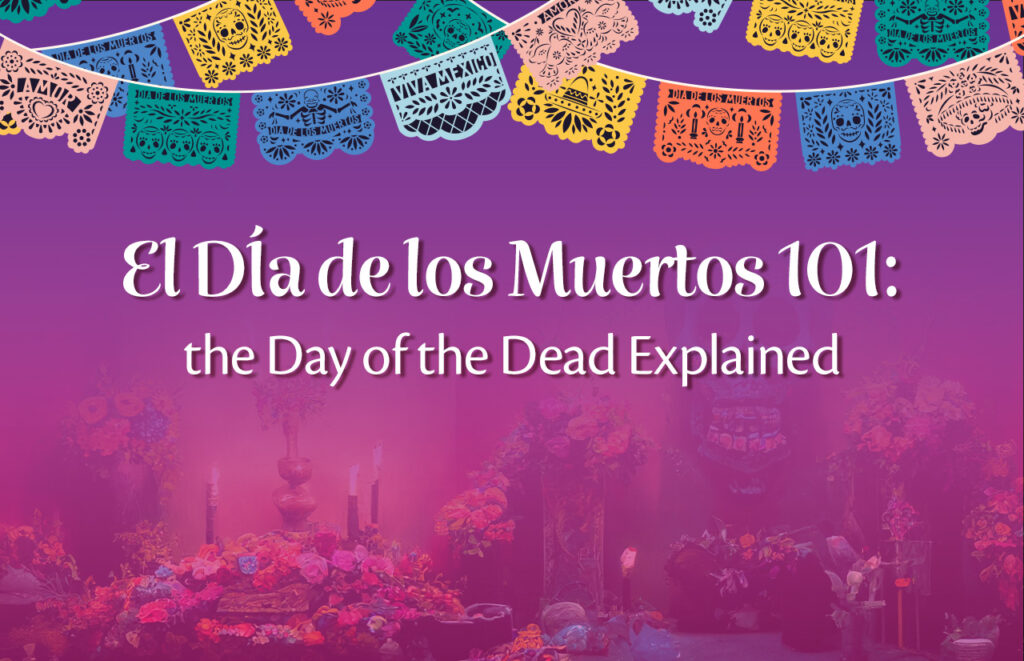El Dia de los Muertos, translated the Day of the Dead, is an annual holiday recognized in Mexico and within Latin American cultures all over the world. It is a time to pay respects to beloved family members and close friends who have moved beyond this planet and on to the spirit world.
Since it is an occasion to honor the deceased (like funerals), one would think that the rituals associated with the holiday would be solemn, but that is not the case at all. In fact, the Day of the Dead is a time of celebration, parties, family gatherings and even humor over the course of 2 full days – November 1 and November 2.
The short answer is that Day of the Dead has been around for a very long time. The beginnings of el Dia de los Muertos go back nearly 3,000 years, arising in the regions of pre-Columbian Mesoamerica (part of Mexico and Central America).
The holiday is believed to have evolved from two things:
1. Ancient Aztec beliefs and rituals
2. Catholicism that was brought to Mexico by the Spaniards
As a result, early Mexicans blended these influences and created a truly unique holiday all their own.
These 4 holidays are sometimes confused – especially Halloween and Day of the Dead. Some people think that it’s the Mexican version of Halloween but as noted already, it is not. Maybe it’s because of the iconic sugar skull art associated with Day of the Dead merging with Halloween’s influx of creepy skeletons every October. Also, their calendar dates are all pretty close. Let’s have a look at the dates and distinctions between them.
Halloween – October 31
Also known as All Hallows Eve, Halloween originated from the ancient Celtic festival of Samhain, during which people would wear costumes and dance around bonfires to scare away ghosts. In present day, it is an occasion for children to dress up in costumes for trick-or-treating and other activities like carving jack-o-lanterns and parties.
All Saints Day – November 1
Also known as All Hallows Day, All Saints Day is a Christian festival held in honor of all the saints of the Western church – those that are known but also those unknown. It is marked by solemnity, prayers, community rituals and liturgical ceremonies.
All Souls Day – November 2
Also known as the Feast of All Souls, All Souls Day is a Christian occasion, especially within the Roman Catholic denomination, meant as a day of remembrance for lost loved ones. It is observed within the church by a unified lifting up of prayers for the souls of the departed. In this way, it is akin to Dia de los Muertos, but only because of the day’s purpose. The expression of these two holidays is completely different.
In many ways el Dia de los Muertos is like a big family reunion for all who celebrate. This is because the occasion is believed to be the only time during the year when the souls of the dearly departed are allowed passage back to the land of the living. So, the graves of those who have passed are always a popular and important place to visit.
However, there are so many other rituals and events that occur over the course of those two days, including decorating with marigolds, the creation of traditional foods and drinks, the making of sugar skulls (vividly decorated skull-shaped artwork comprised of compressed sugar and water), street parades, special family get-togethers and the building of ofrendas.
Building ofrendas are a central tradition in Day of the Dead celebrations. In fact, in some ways, they are what the holiday is really all about. The true meaning of el Dia de los Muertos, so to speak.
Taking much influence from the Aztecs, an ofrenda is an altar created in a family’s home as a shrine to the lost loved one. The shrine is often decorated with marigolds, lit candles, sugar skulls and a set of items associated with the deceased, whether photographs or particular things the person loved. Ofrendas are also filled with food and drink meant as offerings for the departed, and a way to help guide them to the family home during the time that they are free from the boundaries of the afterlife. In a way, it is an annual opportunity for the dead to partake of the earthly pleasures they once enjoyed while communing in the presence of the living.
We hope today’s article was both informative and fun and that it helped prepare you better for the upcoming Day of the Dead celebration. And did you know that The Bradford Exchange offered unique collectibles inspired by el Dia de los Muertos and sugar skull artwork? We invite you to take a look around. You might actually be surprised at all the treats we have in store.
El Dia de los Muertos 101: the Day of the Dead Explained by The Bradford Exchange
